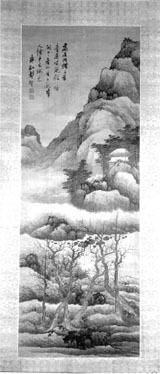The University Record, October 11, 1999 By Joanne Nesbit
New and Information Services

Thanks to the current economic situation in Asia, many superb works of art have suddenly become available on the antiques market. At the Hong Kong Sotheby’s auction last April, the Museum of Art obtained a hanging scroll titled “Mountain Dwelling” by the Chinese master Kung Hsien (c1618–89). An accomplished teacher, poet, calligrapher and painter, Kung Hsien was considered the leader of the Nanking school. Purchase of the scroll was made possible by a special fund for the acquisition of Asian art, part of the Margaret Watson Parker Fund.
Kung lived during a turbulent and chaotic era in Chinese history. Born during the decline of the Ming Dynasty, he witnessed the severe deterioration of the central government brought on by nefarious eunuchs and corrupt officials. In 1644, the Manchus, encouraged by the crumbling state of affairs, invaded and captured Peking and established the Ch’ing dynasty.
“Patriotic artists like Kung were filled with a righteous indignation that often was reflected in their art,” explains Marshall P.S. Wu, senior curator of Asian art at the Museum. “Because of their patriotism and loyalty to the Ming court, later scholars came to designate them as ‘remnant painters.’”
In 1664 Kung Hsien settled in Nanking, where he built a small house on the slope of Mt. Ch’ing-liang, which means “clear and cold hill.” “Kung felt a strong sense of attachment to his home, as evidenced by the many paintings he completed with Mt. Ch’ing-liang as a setting,” Wu says. “The Museum’s new scroll, which includes a small hut perched halfway up a mountain facing a river, depicts this property. Kung’s refined use of this motif can be understood as an invitation to the viewer to immerse oneself in nature.”
“Day after day, I gaze at the mountain and never tire of it. I wonder how many can forget their mundane affairs, exit the city, and enjoy this splendor,” reads Kung’s inscription.

